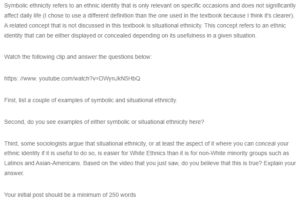Symbolic and Situational Ethnicity
Ethnicity is defined as a social group that one belongs to based on common descent, history, and homeland (Green 2). Symbolic Ethnicity is whereby humans from certain ethnic groups love their culture, tradition, and origin and are proud of it, but they do not incorporate the traditions in their everyday behavior. Situational Ethnicity is when one displays someone displays this ethnic form depending on how useful it is during a certain situation.
An example of Symbolic Ethnicity is when a Muslim woman moves to the United States for marriage and gives birth to her mixed daughter. The daughter does not grow up practicing all Muslim traditions. She is, however, very proud of her Muslim origin and celebrates some religious traditions. An example of situational Ethnicity is when a black man is randomly verbally assaulted by a white lady in a store, then he talks back and gets angry due to the insults. By talking back, he feels the usefulness of his words to work as a shield for him. Get in touch with us at eminencepapers.com. We offer assignment help with high professionalism.
In the video “What Kind of Asian are you?”, It is evident that situational Ethnicity is present since the Asian lady is first calm and talks to the man in a friendly manner until he starts making uncomfortable comments about her ethnic background. She reciprocates the anger by asking the same irritating questions. The lady acted that way because she felt it was necessary to take action due to the comments she received from the man.
I support the notion that concealing ethnic identity is easier for white people than non-white people since, firstly, the minority has always been linked to being non-white (Song). Whites are the majority, so no one will question them like non-whites considering they also appear different, for instance, how Asian eyes appear and the skin color of black people.
In conclusion, both situational and symbolic Ethnicity are a part of human lives since they can be used in different situations and purposes. Situational Ethnicity also helps most people to stand for their rights or fight back.
Works Cited
Green, Elliott D. “Redefining ethnicity.” A Paper Presented at the 47th Annual International Studies Association Convention, San Diego. 2006.
Song, Miri. “Rethinking Minority Status and ‘Visibility.'” Comparative Migration Studies, vol. 8, no. 1, 2020, https://doi.org/10.1186/s40878-019-0162-2.
ORDER A PLAGIARISM-FREE PAPER HERE
We’ll write everything from scratch
Question
Symbolic ethnicity refers to an ethnic identity that is only relevant on specific occasions and does not significantly affect daily life (I chose to use a different definition than the one used in the textbook because I think it’s clearer). A related concept that is not discussed in this textbook is situational ethnicity. This concept refers to an ethnic identity that can be either displayed or concealed depending on its usefulness in a given situation.

Symbolic and Situational Ethnicity
Watch the following clip and answer the questions below:
https: //www. youtube.com/watch?v=DWynJkN5HbQ
First, list a couple of examples of symbolic and situational ethnicity.
Second, do you see examples of either symbolic or situational ethnicity here?
Third, some sociologists argue that situational ethnicity, or at least the aspect of it where you can conceal your ethnic identity if it is useful to do so, is easier for White Ethnics than it is for non-White minority groups such as Latinos and Asian-Americans. Based on the video that you just saw, do you believe that this is true? Explain your answer.
Your initial post should be a minimum of 250 words

